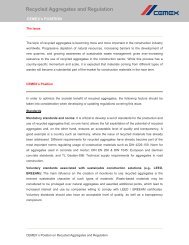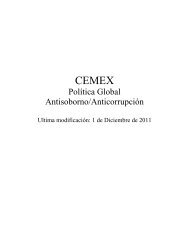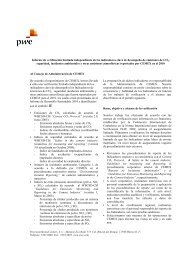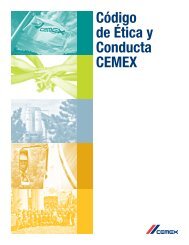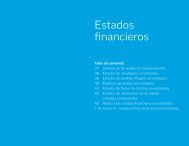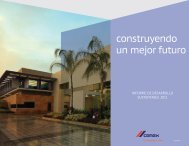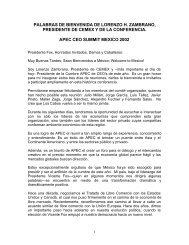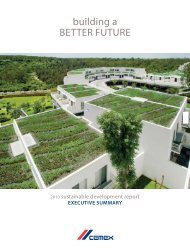building a STRONGER foundation - Cemex
building a STRONGER foundation - Cemex
building a STRONGER foundation - Cemex
Create successful ePaper yourself
Turn your PDF publications into a flip-book with our unique Google optimized e-Paper software.
As required by the directive, each of the member states established a NAP that defines the free allocation to each industrial<br />
facility for Phase II (2008 through 2012). Although the overall yearly volume of allowances in Phase II is significantly lower than that<br />
during Phase I of the ETS (2005-2007), we do not see any significant risk that CEMEX will be short of allowances in Phase II. This<br />
assessment stems from various factors, notably a reasonable allocation policy in some countries, our efforts to reduce emissions per<br />
unit of clinker produced, reduced demand for our products due to the current economic circumstances, and the use of several risk-free<br />
financial instruments. We expect to be a net seller of allowances over Phase II. In addition, we are actively pursuing a strategy aimed<br />
at generating additional emission credits through the implementation of CDM projects in Latin America, North Africa and Southeast<br />
Asia. Despite having already sold a substantial amount of allowances for Phase II, we believe the overall volume of transactions is<br />
justified by our most conservative emissions forecast, meaning that the risk of having to buy allowances in the market in the remainder<br />
of Phase II is very low. As of April 30, 2011, the price of carbon dioxide allowances for Phase II on the spot market was<br />
approximately €16.75 per ton (approximately U.S.$24.83 as of April 30, 2011, based on an exchange rate of €0.6745 to U.S.$1.00).<br />
We are taking appropriate measures to minimize our exposure to this market while assuring the supply of our products to our<br />
customers.<br />
The Spanish NAP has been approved by the Spanish Government, reflecting the conditions that were set forth by the European<br />
Commission. The allocations made to our installations allow us to foresee a reasonable availability of allowances; nevertheless, there<br />
remains the uncertainty regarding the allocations that, against the reserve for new entrants, we intend to request for our new cement<br />
plant in Andorra (Teruel), whose construction has been postponed.<br />
In the case of the U.K., Germany, Poland and Latvia, NAPs have been approved by the European Commission, and allowances<br />
have been issued to our existing installations.<br />
On January 9, 2009, we received a positive answer from U.K. authorities to a request we filed in late 2008 to retain the<br />
allocation of allowances for our Barrington plant after this facility was closed permanently in November 2008 and its production<br />
moved to our South Ferriby plant.<br />
On May 18, 2009, the Environment Ministry of the Republic of Latvia published the amount of allocation of EUAs from the<br />
New Entrants Reserve to our Broceni plant expansion project.<br />
On May 29, 2007, the Polish government filed an appeal before the Court of First Instance in Luxembourg regarding the<br />
European Commission’s rejection of the initial version of the Polish NAP. The Polish government has issued allowances at the level<br />
already accepted by the European Commission, which is lower than the Polish government proposal by 76 million EUA per year.<br />
However, on September 23, 2009, the same Court annulled the European Commission’s decision that reduced the number of EUAs in<br />
the Polish NAP. The Court found that such reduction was not justified, arguing that the European Commission should not ignore the<br />
historical and forecasted data that Poland used to establish the basis of the NAP allocation. On March 19, 2010, the European<br />
Commission and the Government of Poland reached an agreement to maintain the originally approved cap for 2010 through 2012 (the<br />
remainder of the EU ETS Phase II period). On December 4, 2009, the European Commission appealed the Court of First Instance’s<br />
decision to the European Supreme Court, as its resolution could impact similar cases against the European Commission raised by other<br />
Eastern European member states.<br />
Croatia has implemented an emissions trading scheme designed to be compatible with the one in force in the European Union,<br />
although no emission allowances can be exchanged between the two schemes. The first period of compliance is 2010-2012, and the<br />
final NAP was published in July 2009. We do not expect the commencement of the Croatian emissions trading scheme to substantially<br />
affect our overall position, particularly as the allocation to CEMEX Croatia is larger than previously anticipated.<br />
In December 2008, the European Commission, Council and Parliament reached an agreement on a new Directive that will<br />
govern emissions trading after 2012. One of the main features of the Directive is that a European-wide benchmark will be used to<br />
allocate free allowances among installations in the cement sector, according to their historical clinker production.<br />
On April 27, 2011, the European Commission adopted a Decision that states the rules, including the benchmarks of greenhouse<br />
gas emissions performance, to be used by the Member States in calculating the number of allowances to be annually allocated for free<br />
to industrial sectors (such as cement) that are deemed to be exposed to the risk of “carbon leakage”. Based on the criteria contained in<br />
the adopted Decision we expect that the aggregate amount of allowances that will be annually allocated for free to CEMEX in Phase<br />
III of the ETS (2013 – 2020) will be sufficient to operate.<br />
71



